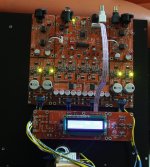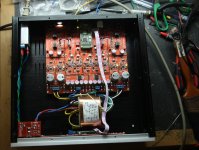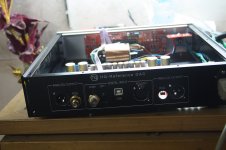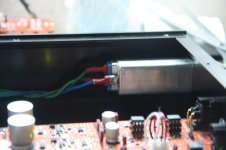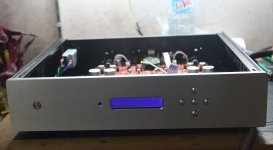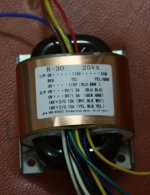Hey Quanghao - asked this on the other page and didn't get much of an answer. I'm paid up for the DAC only; When do you expect that you'll be able to ship mine? misterrogers=JoeAudiophile
I'm sorry, I had to send the goods to you on 05/31/2013, but I forgot to tell you. You can check the tracking numbers of 802 609 632 504.
Thank you.
output stage consideration - part3
This evening I have tested the following configurations with a my friend with lot of experience on audio reprodution and recording.
1) Actual op-amp module (balanced with passive IV 10ohm)
2) Satri design (balanced not suggested because it does not work good on balanced circuit)
3) Raleigh Audio Line Stage clone with K & K Audio Basic CCS modules (balanced current mode with passive IV 10ohm)
4) Un-balanced direct connection in voltage mode with only 2.2uF Z-Cap capacitor (0.1uF bypass MKP1837 as option)
5) Lundahl LL1684 (balanced in voltage mode with OS-CON)
The last is the best.
This evening I have tested the following configurations with a my friend with lot of experience on audio reprodution and recording.
1) Actual op-amp module (balanced with passive IV 10ohm)
2) Satri design (balanced not suggested because it does not work good on balanced circuit)
3) Raleigh Audio Line Stage clone with K & K Audio Basic CCS modules (balanced current mode with passive IV 10ohm)
4) Un-balanced direct connection in voltage mode with only 2.2uF Z-Cap capacitor (0.1uF bypass MKP1837 as option)
5) Lundahl LL1684 (balanced in voltage mode with OS-CON)
The last is the best.
Last edited:
The last is the best.
You really should also try the SEN by EUVL to get a more complete picture.
I have not tried transformers, but the SEN beats the rest i tried by a very large margin.....
Edit: hell, I might even donate a matched set of 2SK369 if you promise to try it seriously......
Last edited:
You really should also try the SEN by EUVL to get a more complete picture.
I have not tried transformers, but the SEN beats the rest i tried by a very large margin.....
Edit: hell, I might even donate a matched set of 2SK369 if you promise to try it seriously......
SEN by EUVL is only a common base I/V, not good for differential DAC chips but it is possible to test it in un-balanced configuraton.
Sure I will try soon the my design based on Phase Tech HD-7A (last balanced current mode).
Also this design use common base as input stage but it is very fast becasue use only current mirror to transfer the signal and it have a very low distortion if compared to normal stages.
output stage consideration - part3
NOTE: In the list of the post #664 the numbers indicate the quality level.
So it mean that the very simple un-balanced direct connection work good also if the signal is low to drive a final amplifier.
The Raleigh Audio Line Stage clone with K & K Audio Basic CCS modules sound good but introduces too many not natural harmonics and these create a lose of coherence.
The Raleigh Audio Line Stage might like if you have a solid state amplifier with a very dry sound and with high feedback.
NOTE: In the list of the post #664 the numbers indicate the quality level.
So it mean that the very simple un-balanced direct connection work good also if the signal is low to drive a final amplifier.
The Raleigh Audio Line Stage clone with K & K Audio Basic CCS modules sound good but introduces too many not natural harmonics and these create a lose of coherence.
The Raleigh Audio Line Stage might like if you have a solid state amplifier with a very dry sound and with high feedback.
Last edited:
SEN by EUVL is only a common base I/V, not good for differential DAC chips but it is possible to test it in un-balanced configuraton.
Hmmm... sound pretty damn good to me with the ES9018 in a balanced configuration
Reading the SEN thread backwards might be more useful to you.
Ciao,
Nic
This evening I have tested the following configurations with a my friend with lot of experience on audio reproduction and recording.
Thanks for trying them out!
Is there a big difference between the different output stages ?
Another option is the es9018 with transformer in current out mode: small resistors in parallel with the primaries and with a tube gain stage behind the transformer.
See schematic 2.
Update shipping list
Hi, until today I had to send the goods to you in the following list and you can track the following tracking numbers:
1/ Daniel: 802609632489
2/ Luizl: 802609632743
3/ Randytsuch: 802609632732
4/ Simon Polz: 802609632456
5/ Halook: 802609632467
6/ Misterwolf: 802609632478
7/ Maxwell: 802609632515
8/ Misteroger: 802609632504
9/ Xtomm: 802609632548
10/ Bobkojek: 802609632559
11/ Danny.66: 802609632526
12/ Kimgiin: 802609632537
Tks!
Hi, until today I had to send the goods to you in the following list and you can track the following tracking numbers:
1/ Daniel: 802609632489
2/ Luizl: 802609632743
3/ Randytsuch: 802609632732
4/ Simon Polz: 802609632456
5/ Halook: 802609632467
6/ Misterwolf: 802609632478
7/ Maxwell: 802609632515
8/ Misteroger: 802609632504
9/ Xtomm: 802609632548
10/ Bobkojek: 802609632559
11/ Danny.66: 802609632526
12/ Kimgiin: 802609632537
Tks!
output stage consideration - part4
In the past I used the transformers as IV converters but I got the best results using high quality resistors as Caddock MK132.
The input impedance of the transformers is very complex and it can create numerous problems in the frequency response especially if we have a high DAC output impedance as in the case of the chip with current output.
In the specific case of the ES9018 and using 3 ohm resistors on output the negative effects can be reduced a lot, but in practice we did an IV conversion with the resistors and we are using the transformer only as unbalancing.
So if we have decided to make an IV resistors convertion why use an expensive transformer to create an un-balanced signal if we need another stage to increase the output level ?
The most simple idea in this case is to use a differential output stage with solid state or vacuum tubes.
--------
In any case I suggest to all to test the direct connection in un-balanced configuration before buy esoteric op-amp because the 1Vrms could be enought for your amp.
My philosophy is always been minimalist, always look for the least number of components on the signal path but respecting the instrumental results.
Thanks for trying them out!
Is there a big difference between the different output stages ?
Another option is the es9018 with transformer in current out mode: small resistors in parallel with the primaries and with a tube gain stage behind the transformer.
See schematic 2.
In the past I used the transformers as IV converters but I got the best results using high quality resistors as Caddock MK132.
The input impedance of the transformers is very complex and it can create numerous problems in the frequency response especially if we have a high DAC output impedance as in the case of the chip with current output.
In the specific case of the ES9018 and using 3 ohm resistors on output the negative effects can be reduced a lot, but in practice we did an IV conversion with the resistors and we are using the transformer only as unbalancing.
So if we have decided to make an IV resistors convertion why use an expensive transformer to create an un-balanced signal if we need another stage to increase the output level ?
The most simple idea in this case is to use a differential output stage with solid state or vacuum tubes.
--------
In any case I suggest to all to test the direct connection in un-balanced configuration before buy esoteric op-amp because the 1Vrms could be enought for your amp.
My philosophy is always been minimalist, always look for the least number of components on the signal path but respecting the instrumental results.
Last edited:
Hi Quanghao, What will those order with chassis be sent out? Cheers
These transformers for this project, and a few pictures when complete DAC
I'm waiting chasis for it, I hope you understood me!
Thanks and best regards!
Attachments
These transformers for this project, and a few pictures when complete DAC
I'm waiting chasis for it, I hope you understood me!
Thanks and best regards!
Hi, cool. Please update my payment status. Paid the balance last night. Many Thanks
OK, it seems if I want to get the best out of the es9018 I should try just a transformer.
Basically there are two options with a transformer only output stage to get 2V:
1) a 1:1 transformer like the LL1684 used like Andrea did or in some semi-current mode like in option C here.
2) a stepup 1:16 transformer like the LL1933 with I/V conversion like Joe did
Now, should I buy a 1:1 or a step-up transformer ?
Some more reading to do...
Basically there are two options with a transformer only output stage to get 2V:
1) a 1:1 transformer like the LL1684 used like Andrea did or in some semi-current mode like in option C here.
2) a stepup 1:16 transformer like the LL1933 with I/V conversion like Joe did
Now, should I buy a 1:1 or a step-up transformer ?
Some more reading to do...
OK, it seems if I want to get the best out of the es9018 I should try just a transformer.
Basically there are two options with a transformer only output stage to get 2V:
1) a 1:1 transformer like the LL1684 used like Andrea did or in some semi-current mode like in option C here.
2) a stepup 1:16 transformer like the LL1933 with I/V conversion like Joe did
Now, should I buy a 1:1 or a step-up transformer ?
Some more reading to do...
As told before I don't suggest an I/V made with a transformer so use only 1:1 configuration with center 10K // 2.2 - 22uF Sanyo OS-CON as described in the old Glass Audio article of Stefano Perugini.
http://digilander.libero.it/paeng/a_24_bit_dac_full_article.htm
Using the Lundahl LL1684 you obtain an extreme quality of sound.
I'm 'asking insistently ESS information about the output stage of the chip ES9018 but still have not been answered
I am convinced that the DAC ES9018 does not switch off the internal IV and always use a voltage output so it is useless reduce the voltage to a few millivolts and after apply a voltage gain.
Last edited:
- Status
- This old topic is closed. If you want to reopen this topic, contact a moderator using the "Report Post" button.
- Home
- More Vendors...
- Quanghao Audio Design
- DAC-END R (ES9018) full assembled board
